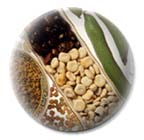- Home
- Introductions

|
Vegetable Seed ProductionGenetic Engineering
Biotechnology and Vegetable Seeds Biotechnology has become a cliché with many different meanings.
The term was first widely used in the 1980s to describe technologies that
allowed foreign genes to be incorporated and expressed in organisms that
were not closely related. Biotechnology in this sense was a significant
development in plant science because previously genes could only be incorporated
through sexual crossing between relatively close relatives within the
same genus. Thus biotechnology enabled genes to be systematically recruited
from diverse plant species or even other organisms for expression in crop
plants. Transgenic VegetablesSome Definitions
Are you eating genetically engineered (GE) food?There are 12 different genetically engineered plants that have been approved for commercial production in the United States. A simple rule of thumb might be that any food containing ingredients from one of these 12 plants could be from a GE variety. Experimentally most crop plants (both monocots and dicots) have be genetically transformed using ballistics or Agrobacterium, but only a handful have been approved for commercial production. It is easier to transform herbacious species than woody species. Genetically Engineered Crops in the United StatesThe following GE crops are the only ones that have been approved for commercial production in the United States:
Examples of Genetically Transformed Crops
Transgenic CropsFrequently-cited estimates that 60% of the food products in the United States contain GE ingredients are due almost entirely to two crops: corn and soybeans. High adoption rates of GE cultivars plus the widespread distribution of corn- and soy-based ingredients in processed foods accounts for the vast majority of foods containing GE. To these, add foods containing oil from canola and cotton, and you cover nearly 100% of the GE plant ingredients in the American diet. SoybeanCultivars of GE herbicide-tolerant soybeans are the most widely-adopted class of GE plants on the market today, accounting for an estimated 74% of the 2002 soybean crop. Soybean-based ingredients -- including oil, flour, lecithin, and protein extracts -- are added to a wide array of processed foods. CornIn the year 2002, about 32% of the field corn crop in the United States was grown to genetically engineered corn hybrids. Because GE corn is not separated from non-GE corn by growers and processors, and because many food ingredients are corn-based, GE corn is likely to be present in most processed foods. GE sweet corn -- sold as fresh ears -- is much less prevalent (3-5%). It is very unlikely that canned sweet corn or popcorn are GE. RapeseedThe United States imports most of its canola oil from Canada, where over 60% of rapeseed (the plant from which canola oil is extracted) are GE varieties. Canola oil is used in a wide array of products, including vegetable cooking oils, salad dressings, margarines, processed cheese, "non-dairy" products, chips, fried foods, cookies, pastries, chocolates, candy coatings, confections, cosmetics, soaps and detergents. CottonGE cotton cultivars now account for 71% of the total 2002 cotton crop. Although cotton is used more for textiles than foods, cottonseed oil may be present in a variety of products, including cooking oils, salad dressing, peanut butter, chips, crackers, cookies, and pastry crusts. PotatoAre you eating GE versions of potato? Probably not. At their peak, GE potato varieties amounted to no more than 2-3% of the potato market in the United States. Due largely to poor sales, all GE potato varieties were discontinued by the developer in March of 2001 and since have not been sold to farmers for planting. Bt and Virus Resistant PotatoesBt potatoes contain resistance to Colorado potato beetle. In 1997, approximately 50,000 acres were planted and in 2003 less than 5,000 were planted. Several virus-resistant potato cultivars have also been released. Squash / ZucchiniAre you eating GE versions of squash? Possibly, but very unlikely. Several varieties of GE yellow crook-neck squash and green zucchini are marketed by Asgrow Vegetable Seed Co., but very few farmers are growing them. PapayaAre you eating GE versions of papaya? Probably not. In the last few years, GE varieties have amounted to more than 50% of Hawaii's papaya production. But most United States papayas are imported from Brazil, Mexico, and the Caribbean (and not GE). Your chances are highest in Hawaii or the continental West Coast. TomatoAre you eating GE versions of tomato? No. Although several GE tomatoes have been approved, only Calgene's FlavrSavr -- a financial flop that was only in a few markets from 1995 to 1997 -- has ever made it to consumers in the United States. Sugarbeets or Garden BeetsAre you eating GE versions of beets? No. Two cultivars of GE sugarbeets have been approved in the United States, but they have never been planted commercially, primarily due to growers' concerns over international markets. RiceAre you eating GE versions of rice? No. Herbicide-tolerant GE rice was cleared for commercial production in 1999 and given FDA approval in 2000. Its developer, Aventis CropScience, has not yet marketed seeds to growers, and awaits EPA approval. SummaryWhether we like it or not, genetically engineered crops are here to stay and will increase in numbers as they are more widely accepted. Leading producers and users include: the United States, Canada, Australia, China, Argentina, and Brazil.
|